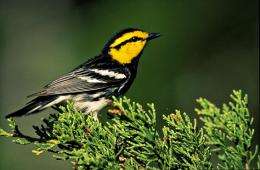Texas AgriLife Research study updates population of endangered golden-cheeked warblers

The projected number of golden-cheeked warbler males across their breeding range in Central Texas is more than previous estimates had indicated, according to results from a Texas AgriLife Research study recently published online in the Journal of Wildlife Management.
The study — the first to survey for the presence of the warblers and their habitat across their entire breeding range — estimated approximately 262,000 male warblers occur within 4 million acres of potential habitat in parts of nearly 40 counties in Central Texas, said Dr. Heather Mathewson, assistant research scientist at the Texas A&M Institute of Renewable Natural Resources and lead author of the paper.
Mathewson said the golden-cheeked warbler was designated as federally endangered in 1990 because of concerns about a small population size and loss and fragmentation of its woodland habitat. Since then, abundance estimates for the species have mainly relied on localized population studies on public lands and qualitative-based methods.
“Those estimates — some now over 20 years old — were often based on a limited amount of data from only a handful of study areas in the breeding range,” she said. “Depending on the data and analyses, estimates varied from roughly 9,000 to 54,000 individuals.”
The paper originated from an AgriLife Research study initiated in 2008 because the only information about the distribution and population of golden-cheeked warblers in Central Texas was limited and outdated, said Dr. Michael Morrison, professor and Caesar Kleberg Chair in Wildlife Ecology in Texas A&M’s department of wildlife and fisheries sciences and lead researcher for the 2008 study.
He said the AgriLife Research team used the range-wide field surveys along with satellite imagery depicting potential warbler habitat to develop and validate statistical models.
“The study was the first time a spatially explicit predictive model for golden-cheeked warblers was used to predict the population across the breeding range,” he said.
A spatially explicit model provides estimates based on features of the birds’ habitat across the range of the species.
“This work is useful to landowners, conservationists and developers because it provides a framework for more reliably predicting abundance and changes in abundance given various changes to the landscape range-wide, such as vegetation removal,” Mathewson said. “It also gives them the ability to evaluate the consequences of losing warbler habitat locally in terms of changing the probability of warblers being present, which is important because of the costs of mitigating for loss of an endangered species’ habitat.”
The AgriLife Research team released a report in 2010 detailing the sampling methods, statistical analyses and results of its study. Morrison said the U.S. Fish and Wildlife Service requested a peer review of the report and associated manuscripts because the importance of the study put it in the category of “Highly Influential Scientific Information.” The peer review was facilitated by The Wildlife Society, the scientific society for professional wildlife biologists and managers.
“The service wanted to determine whether this study represented the best available science and whether our methods and data had been used and interpreted in a reasonable way,” Morrison said. “The reviewers concluded that the overall study design, analyses and inferences are supported by sound scientific data and analysis.”
Mathewson said the report and related publications do not advocate changes in the listing status of the golden-cheeked warbler nor do they imply that conservation measures to protect the species habitat are no longer needed.
“Rather, this study is one of many necessary steps in our evolving knowledge of the golden-cheeked warbler and is not intended as the final word on the matter,” she said.
The peer-reviewed research paper was co-authored by researchers from the institute, including Julie Groce, senior research associate; Tiffany McFarland, research associate; Todd Snelgrove, program specialist; Dr. Bret Collier, research scientist; and Dr. Neal Wilkins, director. Morrison and Dr. Cal Newnam, wildlife biologist for the Texas Department of Transportation, are also authors.
In addition to the paper in the Journal of Wildlife Management, the team has published two additional papers from this study in the peer-review journals, Diversity and Distributions and the Wildlife Society Bulletin. To view a summary of the study and the three papers, go to bit.ly/O1yKIL . The full study report is available on the institute’s website at irnr.tamu.edu/publications/.
Journal information: Journal of Wildlife Management
Provided by Texas A&M University










.jpg)









